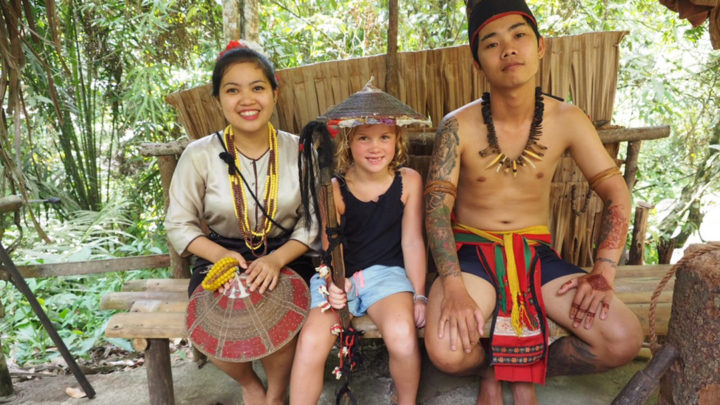Put the Mari Mari Culture Village in Kota Kinabalu on your list as one of the best things to do in Kota Kinabalu. It’s an entertaining and immersive step back into Borneo’s fascinating tribal history. There were 42 tribes in Sabah alone, including headhunters, farmers, crocodile worshippers and rice wine loving warriors, and the Mari Mari Culture Village showcases them in such a fun way the whole family will love it. This is an adventure in Kota Kinabalu not to be missed.
Demonstrations and activities are performed by tribe members, and it’s a really authentic way to learn about Sabah’s tribes. It’s so interactive and fun that we all loved it – trying dart blowing, fresh honey and bamboo chicken, traditional trampoline jumping, getting henna tattoos and learning all about Borneo’s tribes during our visit to the Mari Mari Culture Village.
Each group gets their own personal guide, and our fabulous guide, Shafiq, taught us all about five of these incredible tribes at the Mari Mari Culture Village, a short drive from downtown Kota Kinabalu and set in lush tropical wilderness. Mari Mari showcases each tribe to help guests understand how they lived – from their houses, hunting, farming, cooking and ceremonies and traditions – and gives an amazing insight into the tribal culture.
While you’re in Sabah make sure to explore Kota Kinabalu – read all our Kota Kinabalu suggestions here – visit the Kinabatangan River to spot wildlife and Gomatong Caves on the way there, and Kudat for incredible clear blue water and white sand beaches. Here’s our list for the best Borneo adventure.
How to get to the Mari Mari Culture Village
It’s about 30 minutes from Kota Kinabalu to the centre and if you don’t have your own transport we recommend booking this tour which includes transport and tickets to the Village or this one which also has a trip on the Klias River to see the fireflies in the evening.

Tasting delicious rice wine
How long does the Maru Mari Culture Village tour go for?
The tour goes for around five hours, including a dance performance and lunch.
What happens on the tour?
Let me tell all about our experience at the Mari Mari Culture Village…led by our guide we set off in a small group together.
Our first stop was the Dusun Tribe, farmers who grew rice, vegetables and cultivated fruit trees. They were also hunters and celebrated successful hunts with rice wine, but their biggest celebration was after harvest when the men would drink for two days – which is why the single women slept upstairs with a removable ladder the only entry!
We were shown how rice wine is made and given a little taste – I really liked it, it was like desert wine with a slight vinegar hint. The way to toast is to say ‘aramaiti’ which means together, Nice huh! The Dunsun also distilled rice wine which, unlike the first method which had an alcohol content of 15%, is 40% alcohol. We tasted a very watered down sample, also very yummy. I had a couple of rice wine cocktails the night before at the Shangri-La Tanjung Aru and they were so delicious, with added lemongrass and a mixer. I do like this rice wine.
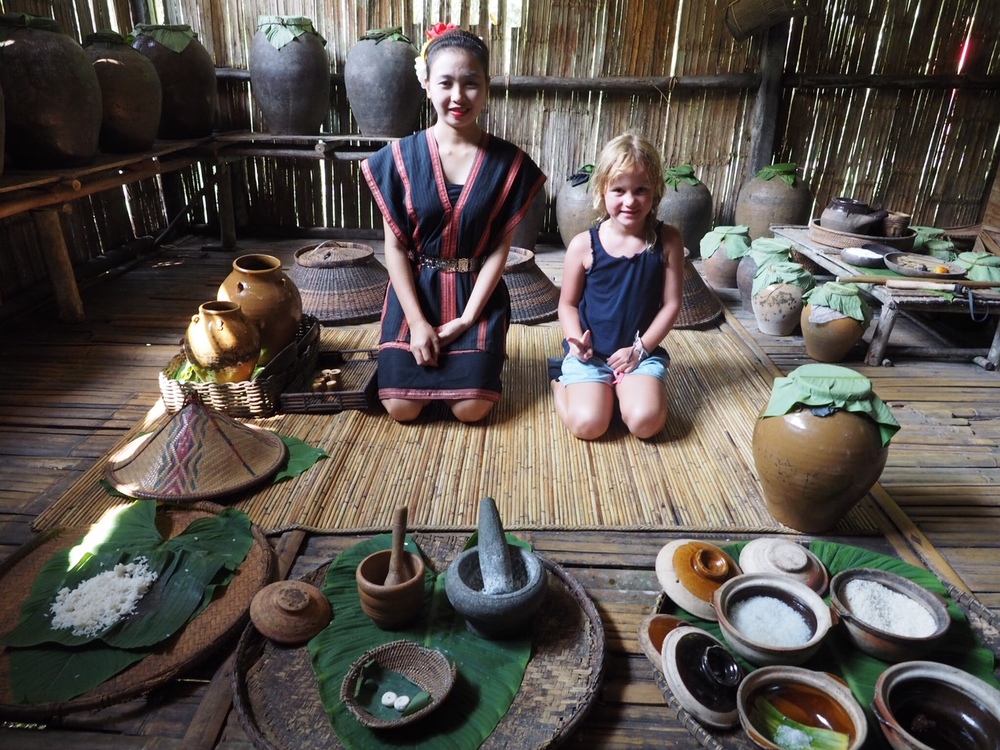
The Dusun tribe’s home and rice wine preparation
I love how the tribes are really advanced in using nature in their daily lives – from building quite elaborate homes – one tribe has an indoor trampoline – to weaponry, clothing and cooking. We tasted a delicious mix of potato, chicken and onion that had been wrapped in banana leaves and cooked in a hollow piece of bamboo over a fire for 15 minutes – ingenious!

This tribe also makes delicious honey by attracting bees into a hollow piece of bamboo with a mix of sugar and honey. The bees then make a hive and produce the honey as well as bees wax which is used as a glue, particularly for fixing together parts of their musical instruments.

The Lundayeh people are an incredibly fascinating tribe – they are headhunters, they make clothing out of tree bark, they worship the crocodile as their symbol of respect and courage and they use large jars as coffins, which they fold the body into and position in trees.
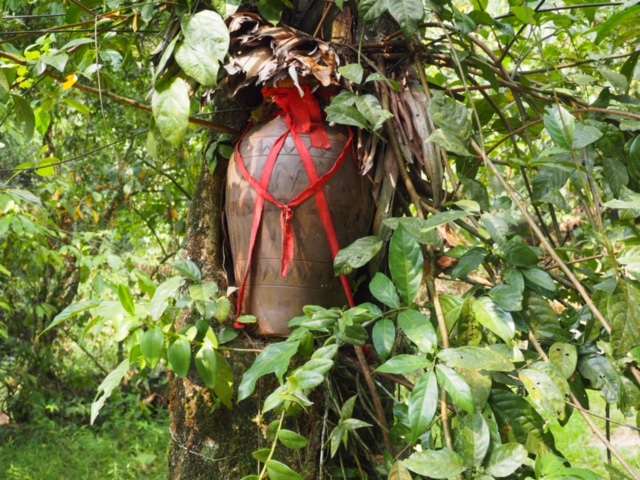
These headhunters use poisonous darts to paralyse their enemies before chopping off their head with a crocodile shaped knife, decorated with the hair of previous victims. They then place the heads on top of a huge crocodile shaped in the grass and dance and sing around it to celebrate.
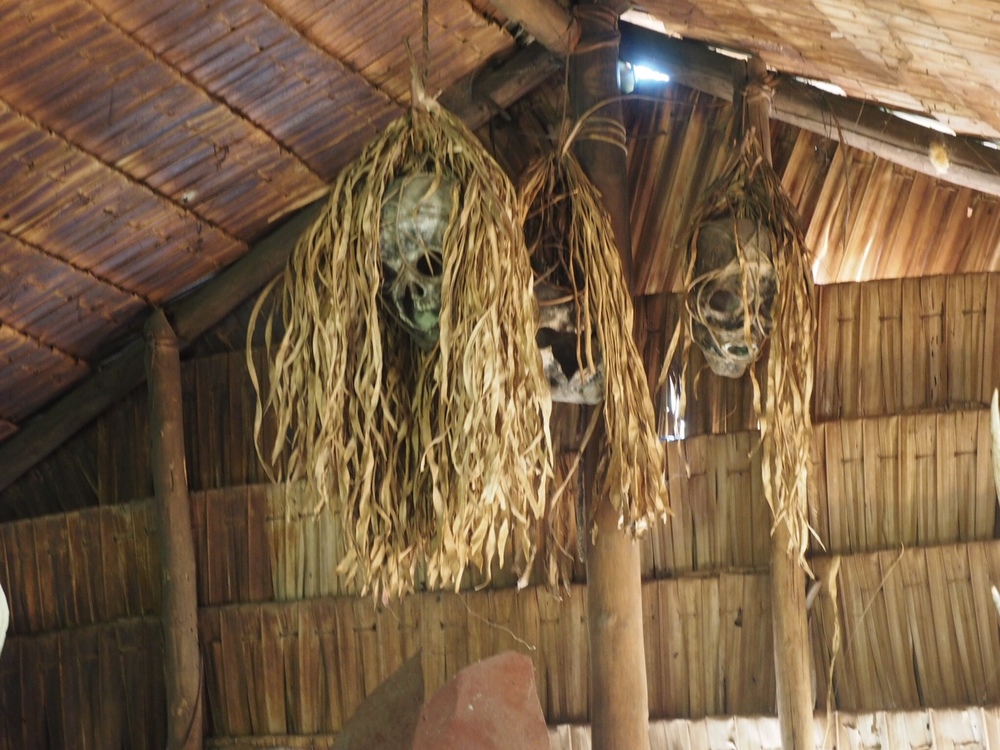
Skulls hanging from the ceiling
Skulls are kept in their homes to show their warrior strength, hanging from the ceiling and adorned with special dried palm leaves, and are used by the high priestess, or shaman. in medicine to sure illnesses. If there are not enough skulls to perform the ritual, the warriors are sent to find more! Large stones with crocodile engravings are positioned around their territory to help warriors navigate their return to the village and warn other tribes to keep out.
The Bajau tribe is originally from the Philippines, and are land and sea dwellers. They are the richest tribe with large, luxurious houses with prayer rooms and nurseries. They are also horse riders, and keep their horses under their raised houses. Large gaps in the bamboo floors enable them to keep watch so the horses aren’t stolen (the first CCTV said Shafiq). We tried a delicious pandan and ginger drink here, and cakes made from flour and sugar.

More delicious traditional treats
Our next visit was to meet with the headhunter tribe. I’d volunteered to be the leader of our group and perform the traditional welcome with the Chief which meant I stood in front of him with my right hand on his shoulder and his on mine and answered questions about where I was from and why I wanted to enter the village. I did okay and we were allowed in, passing by a shaman covered in black and waving smoking palm leaves to bless us as we entered the village.
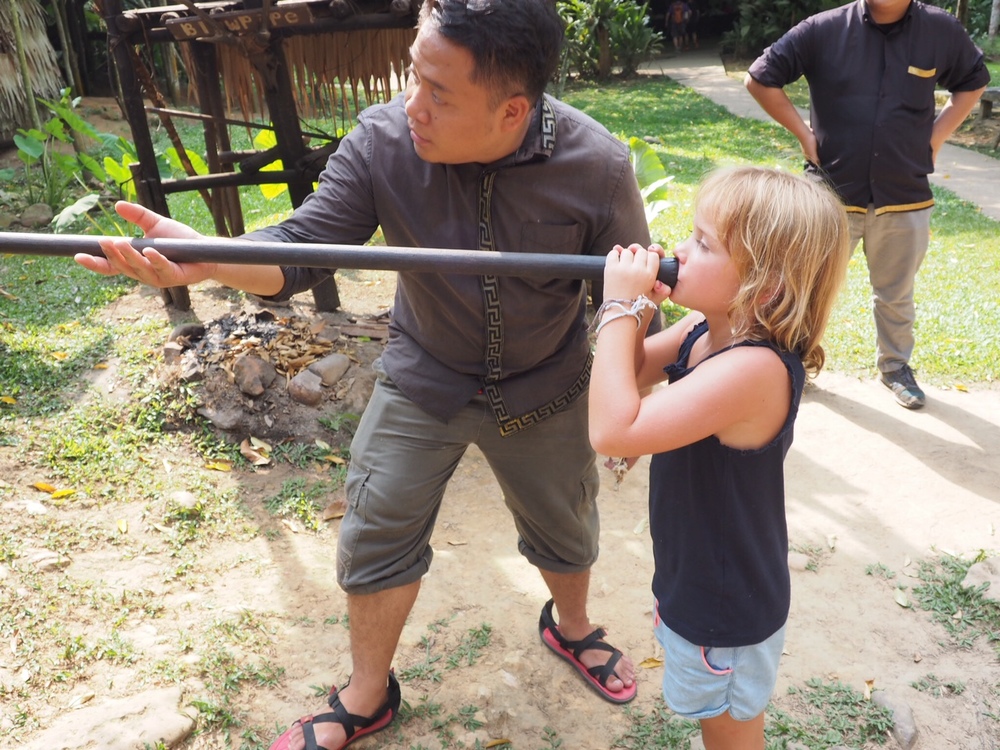
Emmie blowing the poisonous dart under the guidance of Shafiq
Shafiq then showed us the traditional way of blowing poisonous darts through a hollow bamboo tube to hit a target. Our target was a swinging coconut which Shafiq hit effortlessly before giving us all a turn – which we all failed miserably. But I am nothing if not determined so I asked for another try and managed to hit the coconut! Whoop! Was a very exciting moment.

Score! A direct hit!
We then entered the home to find a suspended traditional trampoline on a lowered platform in the middle of the floor. It’s made from strong, flexible wood and woven bamboo. The trampoline was used to celebrate battles and warriors would jump for prizes suspended form the roof. We watched a demonstration and then had a turn of jumping – amazing how bouncy it is!
This was our last house but happily we had a dancing performance to watch – the fastest bamboo dancing I have ever seen – henna tattoos to get on our arms and a delicious afternoon tea of traditional dishes like noodles, chicken, taro and fresh fruit to enjoy.
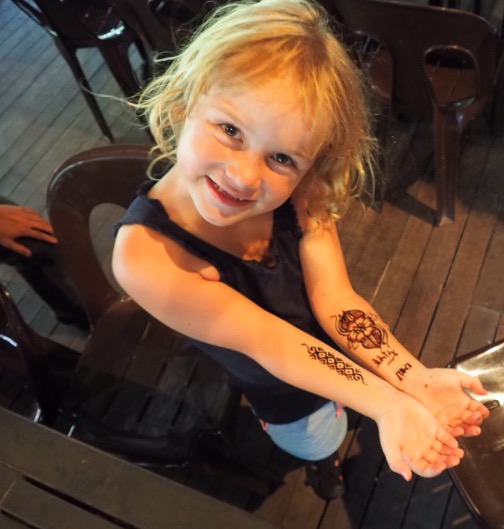
Loving her henna tattoos!
The Mari Mari Culture Village is a must when you visit Sabah, Borneo. It’s professional, authentic, so well organised and educational and so much fun for adults and kids. Getting to try all the food, climb up and down traditional ladders and entranceways, attempt dart blowing and trampolining makes it an easy way for kids to learn while having such a great time. Make sure you go!

